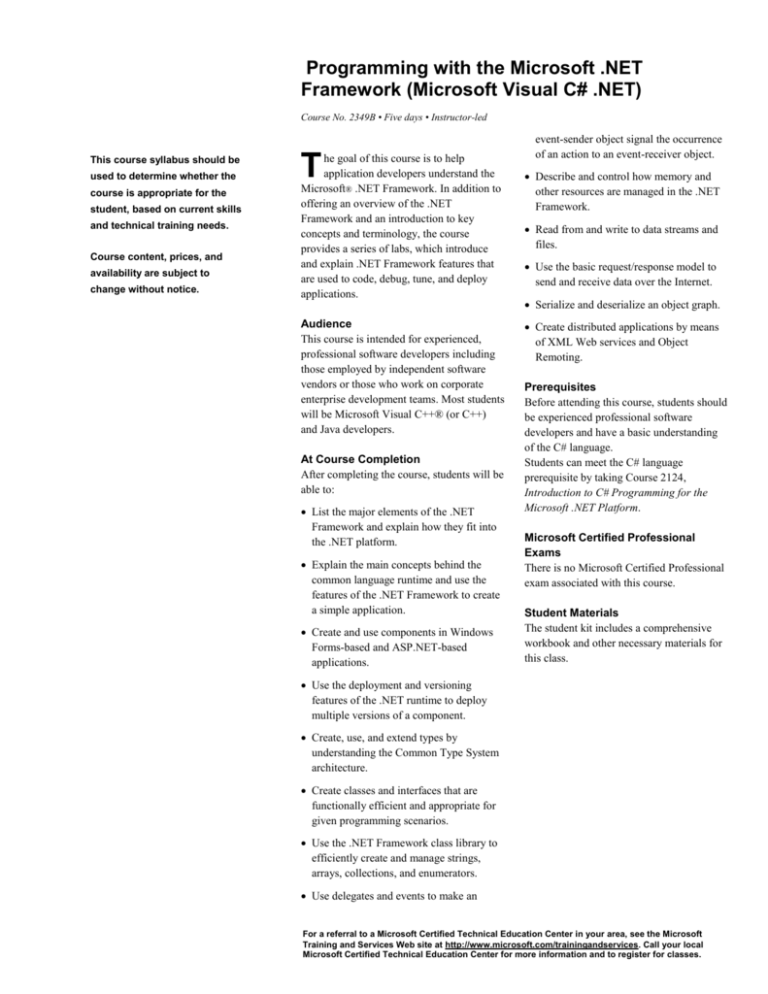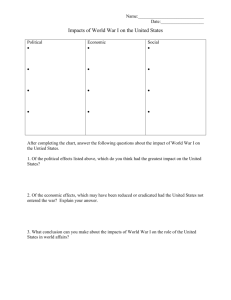
Programming with the Microsoft .NET
Framework (Microsoft Visual C# .NET)
Course No. 2349B • Five days • Instructor-led
This course syllabus should be
used to determine whether the
course is appropriate for the
student, based on current skills
and technical training needs.
Course content, prices, and
availability are subject to
change without notice.
T
he goal of this course is to help
application developers understand the
Microsoft® .NET Framework. In addition to
offering an overview of the .NET
Framework and an introduction to key
concepts and terminology, the course
provides a series of labs, which introduce
and explain .NET Framework features that
are used to code, debug, tune, and deploy
applications.
Audience
This course is intended for experienced,
professional software developers including
those employed by independent software
vendors or those who work on corporate
enterprise development teams. Most students
will be Microsoft Visual C++® (or C++)
and Java developers.
At Course Completion
After completing the course, students will be
able to:
List the major elements of the .NET
Framework and explain how they fit into
the .NET platform.
Explain the main concepts behind the
common language runtime and use the
features of the .NET Framework to create
a simple application.
Create and use components in Windows
Forms-based and ASP.NET-based
applications.
event-sender object signal the occurrence
of an action to an event-receiver object.
Describe and control how memory and
other resources are managed in the .NET
Framework.
Read from and write to data streams and
files.
Use the basic request/response model to
send and receive data over the Internet.
Serialize and deserialize an object graph.
Create distributed applications by means
of XML Web services and Object
Remoting.
Prerequisites
Before attending this course, students should
be experienced professional software
developers and have a basic understanding
of the C# language.
Students can meet the C# language
prerequisite by taking Course 2124,
Introduction to C# Programming for the
Microsoft .NET Platform.
Microsoft Certified Professional
Exams
There is no Microsoft Certified Professional
exam associated with this course.
Student Materials
The student kit includes a comprehensive
workbook and other necessary materials for
this class.
Use the deployment and versioning
features of the .NET runtime to deploy
multiple versions of a component.
Create, use, and extend types by
understanding the Common Type System
architecture.
Create classes and interfaces that are
functionally efficient and appropriate for
given programming scenarios.
Use the .NET Framework class library to
efficiently create and manage strings,
arrays, collections, and enumerators.
Use delegates and events to make an
For a referral to a Microsoft Certified Technical Education Center in your area, see the Microsoft
Training and Services Web site at http://www.microsoft.com/trainingandservices. Call your local
Microsoft Certified Technical Education Center for more information and to register for classes.
Course Outline • Insert Course Title Here
Module 1: Overview of the
Microsoft .NET Framework
The following topics are covered in this
module:
Overview of the Microsoft .NET
Framework
Overview of Namespaces
Creating a simple .NET Framework console application that calls
a component.
Creating a .NET Framework client application by using the
Windows Forms library.
Creating an ASP.NET page that uses the previously developed
.NET Framework component to create an ASP.NET application.
Module 4: Deployment and Versioning
After completing this module, you will be
able to list the major elements of the .NET
Framework. This includes:
Describing the .NET Framework and its
components.
Explaining the relationship between the
.NET Framework class library and
namespaces.
Module 2: Introduction to a
Managed Execution
Environment
The following topics are covered in this
module:
Writing a .NET Application
Compiling and Running a .NET
Application
After completing this module, you will be
able to explain the main concepts behind the
common language runtime and use the
features of the common language runtime to
create a simple application. This includes:
Creating simple console applications in
C#.
Explaining how code is compiled and
executed in a managed execution
environment.
Explaining the concept of garbage
collection.
Module 3: Working with
Components
The following topics are covered in this
module:
An Introduction to Key .NET Framework
Development Technologies
Creating a Simple .NET Framework
Component
Creating a Simple Console Client
Creating an ASP.NET Client
After completing this module, you will be
able to create and use components in
Windows Form-based and ASP.NET-based
applications. This includes:
Creating a simple .NET Framework
component in C#.
Implementing structured exception
handling.
The following topics are covered in this module:
Introduction to Application Deployment
Application Deployment Scenarios
Related Topics and Tools
After completing this module, you will be able to use the deployment
and versioning features of the .NET common language runtime to
deploy multiple versions of a component. This includes:
Packaging and deploying simple and componentized applications.
Creating strong-named assemblies.
Installing and removing assemblies from the global assembly
cache.
Configuring applications to control binding based on assembly
location and version data.
Course Outline • Insert Course Title Here
Module 5: Common Type
System
The following topics are covered in this
module:
An Introduction to the Common Type
System
Elements of the Common Type System
Object-Oriented Characteristics
After completing this module, you will be
able to create, use, and extend types. This
includes:
Describing the difference between value
types and reference types.
Explaining the purpose of each element in
the type system, including values, objects,
and interfaces.
Explaining how object-oriented
programming concepts, such as
abstraction, encapsulation, inheritance,
and polymorphism, are implemented in
the Common Type System.
Module 6: Working with Types
The following topics are covered in this
module:
System.Object Class Functionality
Specialized Constructors
Type Operations
Interfaces
Managing External Types
After completing this module, you will be
able to create classes and interfaces that are
functionally efficient and appropriate for
given programming scenarios. This includes:
Applying attributes to control visibility
and inheritance in classes and interfaces.
Creating and using interfaces that define
methods and properties.
Explaining how boxing and unboxing
work and when boxing and unboxing
occur.
Using operators to determine types at run
time and to cast values to different types.
Explaining what features are available to
work with unmanaged types, such as
COM types.
Module 7: Strings, Arrays, and
Collections
The following topics are covered in this
module:
Strings
Terminology – Collections
.NET Framework Arrays
.NET Framework Collections
After completing this module, you will be
able to use the .NET Framework class
library to create and manage strings, arrays,
collections, and enumerators. This includes:
Parsing, formatting, manipulating, and
comparing strings.
Using the classes in the System.Array
and System.Collections namespaces.
Improving the type safety and
performance of collections by using
specialized collections and class-specific
code.
Course Outline • Insert Course Title Here
Module 8: Delegates and
Events
The following topics are covered in this
module:
Delegates
Multicast Delegates
Events
When to Use Delegates, Events, and
Interfaces
After completing this module, you will be
able to use delegates and events to have an
event sender object signal the occurrence of
an action to an event receiver object. This
includes:
Using the delegate class to create typesafe callback functions and eventhandling methods.
Using the event keyword to simplify and
improve the implementation of a class that
raises events.
Implementing events that conform to the
.NET Framework guidelines.
Module 9: Memory and
resource Management
Module 10: Data Streams and
Files
The following topics are covered in this
module:
Memory Management Basics
Non-Memory Resource Management
Implicit Resource Management
Explicit Resource Management
Optimizing Garbage Collection
The following topics are covered in this
module:
Streams
Readers and Writers
Basic File I/O
After completing this module, you will be
able to describe and control how memory and
other resources are managed in the .NET
Framework. This includes:
Describing how garbage collection
manages object memory.
Implicitly managing non-memory
resources by using a destructor’s finalize
code.
Explicitly managing non-memory
resources by using client-controlled
deterministic release of resources.
Writing code by using the temporary
resource usage design pattern.
Programmatically controlling the behavior
of the garbage collection.
Describing advanced garbage collection
features.
After completing this module, you will be
able to read from and write to data streams,
files, and the Internet. This includes:
Using Stream objects to read and write
bytes to backing stores, such as strings and
files.
Using BinaryReader and BinaryWriter
objects to read and write primitive types as
binary values.
Using StreamReader and StreamWriter
objects to read and write characters to a
stream.
Using StringReader and StringWriter
objects to read and write characters to
strings.
Using Directory and DirectoryInfo
objects to create, move, and enumerate
through directories and subdirectories.
Using FileSystemWatcher objects to
monitor and react to changes in the file
© 2001 Microsoft Corporation. All rights reserved.
This syllabus is for informational purposes only. MICROSOFT MAKES NO WARRANTIES,
EXPRESS OR IMPLIED, IN THIS SUMMARY. Microsoft, MS-DOS, Windows, Windows NT,
ActiveX, IntelliMirror, JScript, MSDN, MSN, PowerPoint, SQL Server, Visual Basic, Visual C++,
Visual C#, Visual FoxPro, Visual Studio, Win32, and Windows Media are either registered trademarks
or trademarks of Microsoft Corporation in the United States and/or other countries. Other product and
company names mentioned herein may be the trademarks of their respective owners.
system.
Explaining the key features of the.NET
Framework’s isolated storage mechanism.
Module 11: Internet Access
The following topics are covered in this
module:
Internet Application Scenarios
The WebRequest and WebResponse Model
Application Protocols
Handling Errors
Security
Best Practices
After completing this module, you will be
able to use the .NET Framework classes to
work with data over the Internet. This
includes:
Using the basic request/response model to
send and receive data over the Internet.
Using the System.Net classes to
communicate with other applications by
using the Hypertext Transfer Protocol
(HTTP), Transmission Control Protocol
(TCP), User Datagram Protocol (UDP),
and Socket Internet protocols.
Module 12: Serialization
The following topics are covered in this
module:
Serialization Scenarios
Serialization Attributes
Object Graph
Serialization Process
Serialization Example
Deserialization Example
Custom Serialization
Custom Serialization Example
Security Issues
After completing this module, you will be
able to serialize and deserialize an object
graph. This includes:
Writing an application that serializes and
deserializes an object graph by using either
a binary or Simple Object Access Protocol
(SOAP) XML format.
Module 13: Remoting and XML
Web Services
The following topics are covered in this
module:
Remoting
Remoting Configuration Files
XML Web Services
After completing this module, you will be
able to create distributed applications by
means of XML Web services and Object
Remoting. This includes:
Writing and configuring distributed
applications that use .NET Remoting.
Creating an XML Web service by using
Visual Studio .NET and ASP.NET.
Consuming an XML Web service by using
the Web Services Description Language
tool (Wsdl.exe).








